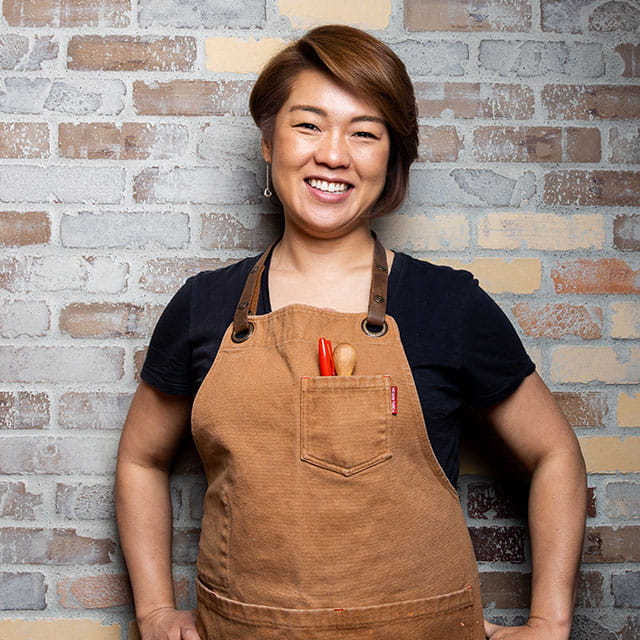
Chef Jinhee Lee
We stopped by Jin Bar to hear more of her incredible journey towards becoming Calgary’s Korean comfort go-to. View Culinary Connections for more.
Read BioJacob Lefenfeld is co-owner and bar manager of Baltimore’s Basque-inspired La Cuchara. Rated “Best Bar Program” in the city by The Baltimore Sun, Lefenfeld is used to pushing the boundaries and leading beverage innovation. His approach to beverage development incorporates flavour-forward techniques from the back of house, especially in using spices and herbs in his drinks. In collaboration with McCormick Chef and culinary mixologist Gabby Quintana, Lefenfeld discusses the nuances of black pepper flavour and his winning approach to cocktail development.
What aspects of pepper do you like the most, and how do you feel it factors into cocktail culture?
Pepper creates a deeper, savoury flavour, which people want to see more of in cocktail culture. I see a lot of customers moving away from overtly sweet drinks, and seeking out more complexity and balance. I think most classically sweet drinks actually benefit from a dash of black pepper, since it adds a lot more depth to what often can be a one-dimensional cocktail. It adds a nice back bite of heat, but it doesn’t overwhelm. It’s very much a perfect accent, where it contributes enough notes in the background that makes the main flavors pop. A good pepper should add to what the chef or bartender is trying to express–not alter the dish.
What do you find to be the key to flavour balancing? How do you figure out where to start when developing a cocktail, and deciding where to go profile-wise?
The starting point is always the base spirit I want to work with: selecting the centrrpiece, examining its unique characteristics, and building upon them in a way that is not only exciting, but also logical. I isolate the individual flavours that come together to make that spirit complex and seek out ingredients I feel with naturally highlight them, and also add some depth to bring certain notes forward. A lot of it is trial and error. Something that sounds crazy might actually balance well. You just have to be willing to fail and start all over again.
You use a number of surprising ingredients in your cocktails, such as butternut squash. How do you go about creating things like that?
Personally, I benefit from Ben’s culinary experience–he’s not just the chef and my business partner, but also my brother. Bartenders who learn from the kitchen have an extra card to play in development. Seeking out not just ingredients, but methods and techniques that are traditionally used only in the kitchen opens up a whole new playing field behind the bar.
Customers still love the classics, but they’re also seeking out exciting new cocktails and expect innovation and surprises. They love trying cocktails that have unexpected flavours they never would have thought worked together until we show them they do! And that’s really our job, isn’t it?
La Cuchara is a Basque restaurant, which is a type of cuisine many people may not be familiar with. What do you consider when designing a cocktail to complement a Basque menu?
The Basque region is located right between Northern Spain and Southern France, and pulls influences from both regions to create a truly unique cuisine. My brother and I have done a lot of travelling, and this was the one place that captivated us like no other. France and Spain are two of the world’s most culinary rich countries, and in the Basque region you get to experience the best of both of them.
When designing the cocktails for La Cuchara I try to use items that are prominent in the region. This includes gin, armagnac, and most especially Vermouth. Different Vermouths from different sub regions can radically alter a cocktail. Remember that it’s not a spirit, but a fortified wine, and as we all know wine is shaped nearly entirely by the nature of where it’s produced. Vermouths vary just as wildly: some are more herbaceous than others; some particularly sweet; some intensely floral. You can actually make the same cocktail hundreds of different ways, all by using different Vermouths from different regions–it’s that unique as an ingredient.
Is there a particular cocktail you’ve created where you found that black pepper really shines?
One of my favourite uses of black pepper comes as a main ingredient on our cocktail Sangre del Toro, or “blood of the bull”. It’s a variation of a gin and tonic that has a bit of sweetness thanks to a black peppercorn-infused simple syrup, and is then topped with a Black Pepper Beet Espuma and finished with cracked black pepper. The black pepper not only tempers the sweetness, but helps pronounce the earthy flavor imparted by the red beets.
Stepping out from behind the bar, are there any foods you find pair exceptionally well with black pepper that people wouldn’t normally think of?
I truly enjoy it when pepper is included in a sweet dessert, such as a black pepper angel food cake inspired by our pastry chef Carrie Goltra. She has actually used black pepper in several of the desserts she’s created for us, like our roasted pineapple sorbet with black pepper marshmallows, and our cinnamon churros that are spiced with pepper and annatto and served with a warm chocolate sauce.